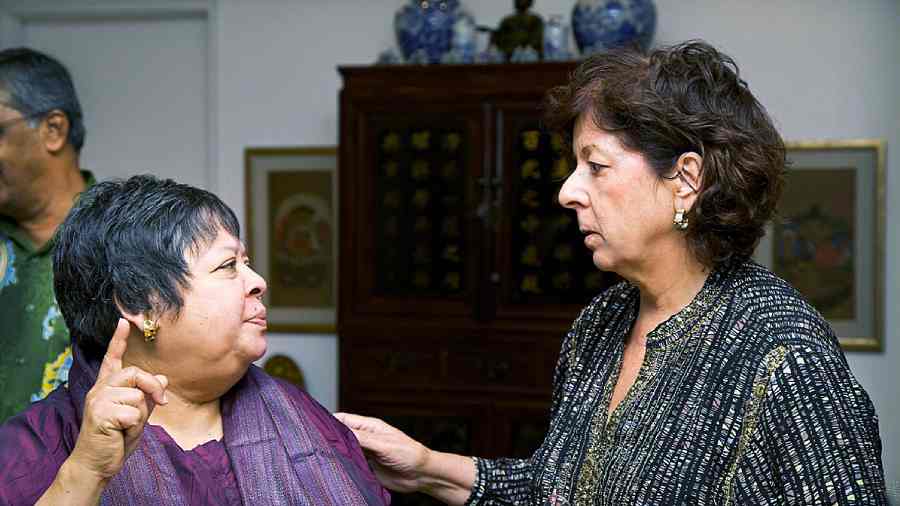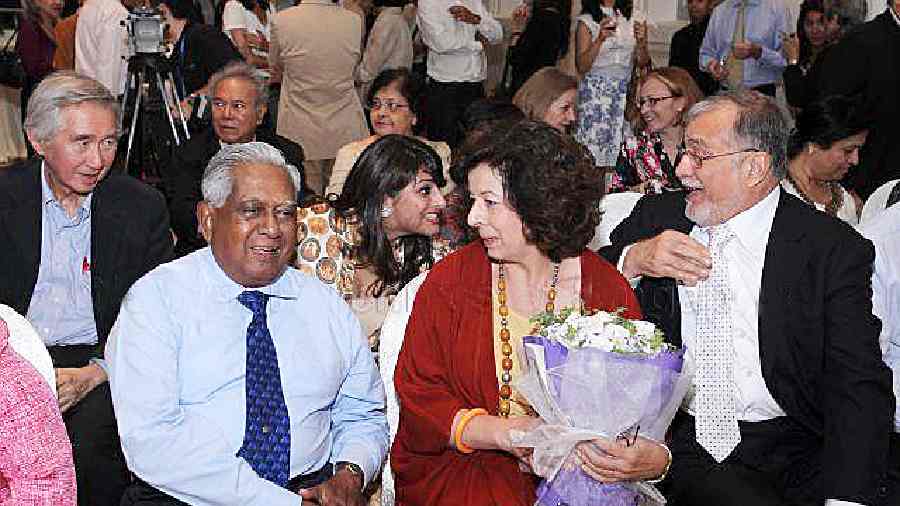I t is not often that the president of Singapore — or any country — calls and says: “Would you please write a novel about Singapore?” But it does happen to unique people, like author Meira Chand. She wrote A Different Sky at Singapore president S.R. Nathan’s request. Now known as the national novel of Singapore, upon its publication it became Book of the Month choice by Waterstones, got into Oprah Winfrey’s recommended reading list, and was long-listed for major literary award in 2012. Chand is of Indian-Swiss parentage and was born and educated in London. In 1962 she moved to Japan with her husband, then to Mumbai in the early Seventies and now lives in Singapore. Her novel Sacred Waters is a somewhat fictionalised story of the Rani of Jhansi Regiment and her book of short stories on India will be out soon. Excerpts from an interview with The Telegraph:
You had once described an encounter as a child on a beach, which lit the fire in you about the issue of identity. I wonder if you could recount that incident briefly and tell us why it was such an important moment to shape your ideas as a writer about identity and belonging.
The incident you speak of happened when I was about five years old. I was with my parents on a beach in Devon in the southwest of England. I had wandered off and was approached by a strange man who gave me a coin and asked me where I was from. I told him I was from India. My father, who had been watching from a distance, came running up. I next remember my father asking me what the man had said. “Never tell anyone you are Indian. Say you are English,” my father told me angrily. He took the coin from my hand and threw it far out to sea.
In that moment my father woke me to the racial complexity of myself, that has followed me all my life. He told me quite literally to turn brown into white. He ordered me to deny him, and so to deny a whole half of myself. The very identity he had given me, and that only moments before I had voiced so easily on that beach, he told me to reject. The confusion grew in me and filled me for life. If already my cultural fragmentation was not enough, I had now been spliced through the root.
Has the ethos evolved since that day at the beach?
I should clarify that the incident recounted above took place in the 1940s, when Britain was at the height of its colonial power, when brown faces on British streets were unknown, when an interracial marriage such as my parents’ was a rare occurrence that brought stigma and rejection to the couple concerned. My Swiss grandparents disowned my mother for many years. Yet, later, my pioneer father went very successfully into local politics, stood for parliament and became a well-known and much-loved figure. He paved the way for men like today’s Rishi Sunak, Britain’s first prime minister of Indian blood.
Your two most recent pieces of fiction, Sacred Waters, about Netaji Subhash Chandra Bose’s creation of the women’s wing of his Indian National Army, and your about-to-be-published book of short stories, are both on India. After a cache of over 10 books written mainly on Japan and Singapore, what is the impulse that draws you back to your roots?
In the early 70s I lived in India for six years, in Mumbai. It was my first encounter with India and it deeply affected me. Just as in England I am called Indian, in India, I am called British. But I felt a sense of spiritual oneness with the land at the deepest level. Although in many ways India is much changed since the time I lived there, there is always a part of India that is unchangeable and unchanging. It is that India that these stories relate to. I am happy they will at last be collectively published.
The concept of Sacred Waters found seed in your doctoral work — your thesis at the Universityof Western Australia comprised a novel entitled Brave Sisters and an accompanying essay entitled A Study of Ambivalence and Change: Indian Woman — Warrior or Victim? How did Brave Sisters transform into Sacred Waters?
Sacred Waters began, as you rightly point out, as a doctoral thesis. Its inspiration was an old black-andwhite photograph I came across, of a young Indian woman of probably humble origins, and a new recruit of the newly formed Rani of Jhansi Regiment of the INA. She is in a white sari, for, as yet, the regiment had no uniforms, and is grasping a rifle. The expression on her face is one of pride and hesitancy as she stands poised to step outside her prescribed life role of obedient female, and assert agency against an inflexible patriarchal tradition.
It was that woman’s imagined journey from disempowerment to empowerment that began my own journey with the book. Once the academic novel was finished I thought I could easily get it published in the greater world, only to discover that a novel written for academic purposes is a very different creature than a novel written from a deeper source. My agent refused it. I then rewrote the book, putting in a modern timeline and modern characters, and the book became a different thing entirely; it became Sacred Waters.

Meira Chand (right) with the author. Picture courtesy Julie Banerjee Mehta
The nexus of history and fiction is an area much debated by historians and novelists. How so?
Fiction is about emotions and relationships. It brings the past alive in the present and shows us that people at any time in history feel the same emotions and that our ancestors were little different than ourselves. In this way the historical novelist holds a key to opening a door on the past.
Sita, the main protagonist of the novel, is an orphaned, illiterate lower-class woman who has been a child widow in India before arriving in Singapore and remarrying. What was it that drove you to create this character?
The book explores female disempowerment, what it does to a woman, and how agency and empowerment change her. I wished to begin the book by showing the reader the lowest points of disempowerment a woman can be subjected to, and those points were infanticide and child marriage, and Sita’s life journey began at that point. Infanticide is surely the utmost level of disempowerment a female can experience — to be annihilated at first breath.
Tell us about your research.
The INA was based in Singapore, so there were a few women near me, although very elderly, who had been Ranis and who I could personally meet and interview. For my purposes, I found the National Archives in Singapore of far more help than the British Museum library.

Meira Chand with Singapore president S.R. Nathan on her right, and her husband Kumar Chand on her left at the launch of A Different Sky. Picture courtesy Meira Chand
Many of your readers would be interested in your writing process. I know when you wrote your first novel The Gossamer Fly, you say “the book wrote itself”. It was as if it was dictated to you from an unseen force within.
Yes, that first novel, The Gossamer Fly did sort of almost write itself. After that, I had to learn my craft. I write every day, I sit down at my desk at about 10am or 11am, and I am there until mid-afternoon or longer. Contrary to what most people think, novel writing is hard work and sustaining the weight of a novel over a long period of time is also difficult. It is a job and a profession, but also a calling. A little of what happened in The Gossamer Fly must happen in every successful novel. At some point a novel must, like an aircraft taxiing down a runway, achieve lift-off. It must develop a life of its own and demand the writer take unthoughtof risks. I once came to my desk one morning to find a character waiting for me who I had not consciously thought of before, demanding a place in my book. I put him in reluctantly, and he eventually became a main character! These things happen. My novel of Mumbai, House of the Sun, like The Gossamer Fly, almost wrote itself, dragging me along behind it.
How do you see yourself today as a Singaporean writer who has an international following of readers and has written persuasively about Japanese life and India?
I have lived for extended periods of time in so many different parts of the world, and in every place, including the land of my birth, I have been seen as an outsider. I am deeply grateful for the acceptance Singapore has offered me, even if I am still viewed essentially as an outsider. For the first time in Singapore I have a feeling of inclusion, of being able to contribute to the society I am living in. That is a very good feeling for me. But in the end, after a lifetime as an outsider, home is within myself.
Julie Banerjee Mehta is an author of Dance of Life and co-author of the bestselling biography Strongman:The Extraordinary Life of Hun Sen.She has a PhD in English and SouthAsian Studies from the University of Toronto, where she taught WorldLiterature and Postcolonial Literature for many years. She currently lives in Calcutta and teaches Master’sEnglish at Loreto College
SACRED WATERS : Victorious Sita, leader of the INA Jhansi Regiment

“Historical Fiction is a form of literary archaeology. The writer journeys to a site to examine its remains and reconstructs the world these remains imply,” says Meira Chand.
With an impressive body of fiction published by international publishers under her belt, in Sacred Waters Chand shines the spotlight on Netaji Subash Chandra Bose’s substantial role as a force that paved the path for women’s empowerment when he created the women’s wing, the Rani of Jhansi Regiment, of his Indian National Army, which was headquartered in Singapore and Rangoon during World War II. The army was made up of about 40,000 men, and the armed Rani of Jhansi Regiment had about 1,000 Indian women soldiers at its height.
“It is estimated that 80 per cent of recruits were the wives and daughters of illiterate Tamil labourers working on the coloniallyowned rubber estates of Malaya. The issues of gender, and illiteracy and low caste of these women have worked towards their lack of voice in history,” says Chand.
She traces the history of the protagonist Sita’s long journey from an orphaned, illiterate lower-class woman in rural north India who is “a living dead”, forced to commit female foeticide in the sacred waters of Indian rivers, to becoming a leader in Rani of Jhansi Regiment in Singapore. Sita becomes diasporic, wrested by destiny from her home, and, like her creator, is without a home, always an outsider in a patriarchal society that uniformly marginalises women.
Chand has gone that extra length to excavate the real lives of women in the Rani of Jhansi Regiment and used the seismic cultural blot of female infanticide to connect the local to the global. The methodology the writer uses to mine the oral and written archives in Singapore, and the UK, to present a complex narratology with elements of historical suspense that hook the reader right from the gripping prologue.
“Without exception, each woman I interviewed said their years in the Rani of Jhansi Regiment were the best years in their lives,” says Chand. The overwhelming sadness that grips the reader is a sadness that is transformed from the women who are told to return after World War II to their earlier lives, before they joined the Regiment, and become wives and mothers, again, and serve their families. It is almost as if there was no existence of the Rani of Jhansi Regiment!
